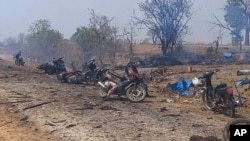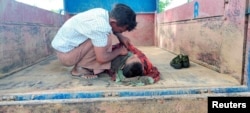Myanmar’s military government continues to pick up the pace of deadly airstrikes against a growing armed and civil resistance to its rule, more than two years after seizing power in a coup. Rights groups and analysts say most of their targets and victims are civilians.
“The Burma military airstrikes have gone past anything we’ve ever seen in Burma,” said David Eubank, head of the Free Burma Rangers, a Christian aid group at work in the country’s east for the past 30 years, using another name for Myanmar.
“It is an all-out onslaught. There hasn’t been a day that’s gone by that we’ve been here that there hasn’t been a bombing somewhere,” he told VOA from Karenni state, in Myanmar’s east, speaking of the past few months.
Countrywide data on reported airstrikes back up the accounts from rights groups, charities and resistance forces of Myanmar military jets, helicopters and drones bombing, rocketing and strafing targets across Myanmar at unprecedented rates.
Picking up the pace
The International Institute for Strategic Studies, a British research group, has been keeping a detailed tally of the fighting in Myanmar since the February 2021 putsch that ousted an elected government. It counted an average of 49 airstrikes per month by the Myanmar military from January through April, about 25% higher than the 39 average monthly strikes last year.
The Armed Conflict Location and Event Data Project, or ACLED, based in the United States, has also tracked a steady and ongoing rise in airstrikes, including upwards of 150 over the first three months of this year, more than in any quarter since the coup.
The increase in airstrikes comes with a rising death toll, according to the project. It counted 146 deaths from the military’s air attacks from January through March, also the most of any quarter since the coup.
The project has counted another 330 deaths from airstrikes since the end of March, including an April 11 attack that killed at least 160 men, women and children gathered for a celebration in central Myanmar’s Sagaing region.
A military spokesman said the strike targeted armed resistance groups and attributed the high death toll to having hit one of the groups’ explosives depots.
Most of the junta’s fighting has been on the ground. The IISS and ACLED data show airstrikes not just picking up, however, but accounting for a growing share of all military action.
Matthew Arnold, an independent security analyst, says the military keeps ratcheting up the air war to make up for its mounting loss of control over swaths of the country.
“On the ground they’re struggling militarily, and so they have to rely on air power more. That’s very clear, especially in places like Chin, western Magwe ... western Sagaing, and then also in Karenni,” he told VOA.
Arnold said the military lacks the armored personnel carriers to cope with resistance forces ever more adept at ambushing convoys, laying roadside explosives and using its own jerry-rigged drones to drop bombs, and has even resorted to commandeering dump trucks to move troops.
“They’ve tried to use ... dump trucks because they have the heavy back, but there just aren’t enough of those to go around. And so they’re just taking significant losses from ambushes, IEDs, drones on their land movements, so predictably they fall back on air assets,” he said.
Clinics, schools, churches
Aid groups say civilians are bearing the brunt of the strikes.
“What we’ve seen, at least in the last month, most of the airstrikes that have happened in civilian-populated centers, they have been targeting churches, schools and hospitals. Those are the largest buildings in the villages,” said Salai Za Uk Ling, deputy director of the Chin Human Rights Organization, a local charity that delivers food, medicine and other critical aid to families displaced by the violence across western Myanmar.
“We have seen ... an increasing number of airstrikes in villages even when there’s no resistance group present,” he added.
Near Camp Victoria, a major base for the armed resistance in Chin state, Biak Cung Lian says an airstrike hit his hospital on January 11. A large bomb destroyed the outpatient building, caused the roof of the operating room to cave in, and blew out all the windows, he told VOA.
Luckily, he said, staff had already evacuated the compound of dozens of patients, mostly civilians, after bombs started falling the day before.
“We are so lucky that the outpatient department was not hit on the first day, [otherwise] there would be a lot of casualties,” said Biak Cung Lian.
“Targeting these kinds of schools and hospitals, it’s a very inhuman act,” he added. “It shows ... they cannot fully win [against] the resistance forces, [but] the civilian people are very easy to be targeted, so they are just bombing [them].”
The frequency and consistency with which the airstrikes are hitting civilian targets has charities, rights groups and analysts convinced they’re expressly in the junta’s crosshairs.
“Every single hospital up here and every clinic has been bombed in Karenni, and many in Karen state and Chin as well,” said Eubank, a former U.S. Special Forces officer.
“Before, the Burma army would attack hospitals, clinics and churches, but it was more episodic.... They’d burn a church in one village and they wouldn’t burn a church in another. They’d destroy a clinic in one place and maybe not in the other. But since the coup, I believe completely it’s a policy,” he said.
More of the same
The military’s latest purchases suggest more of the same to come.
In a report out in May, Tom Andrews, the United Nations’ special rapporteur on human rights in Myanmar, details some $1 billion worth of imports of arms, military equipment, dual-use items and raw material for making weapons since the coup. It shows most of the imports from Russia and China, the junta’s main arms suppliers, are fighter jets, attack helicopters and the spare parts to keep them flying.
“It just affirms ... that they can’t control ground terrain, and so they expect to compensate through air assets,” Arnold said.
Whether the junta can maintain, or even scale up, the pace of airstrikes for much longer is another matter, he added, strapped as it is for cash by a plummeting economy and having, in Russia, a key supplier bogged down with Moscow’s war in Ukraine.
In any case, Arnold said he believes the junta’s air war simply won’t work.
He said the military lacks the complex coordination between air and ground forces needed to hit actual enemy targets accurately, especially in the mountains where much of the armed resistance is, and that repeatedly hitting civilian targets instead only feeds popular resentment of an already widely reviled regime.
“Fundamentally, there’s never been an insurgency or rebellion that was put down by the use of air attacks,” he said. “Definitely it causes damage, mostly against the civilian population, but it’s in itself not enough to fundamentally compensate for the lack of ground control.”













